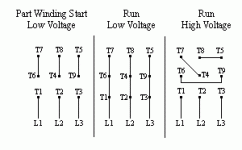plumberpieco
Cast Iron
- Joined
- Feb 27, 2010
- Location
- cleveland
I have a motor that gets wired double delta for 220 3ph and delta for 440v 3ph. I’ve re wired from 440 to 220 according to the motor plate Along with the control transformer but the motor will not spin up to speed. Thought maybe my RPC could be the issue so for the heck of it I hooked up a vfd directly and it still won’ get up to rpms and rotates slowly and hums loudly same as on the rpc. Lathe was previously hooked up to 480v when inspected. Now I’ve searched far and near to find info on double delta and am not finding much. Motor is 5hp in a Mori Seiki MS850. Now if I take the belts off the motor will spool up no problem. My RPC is made by Kustom Built 5hp and output rating is 15amp 220v. The Mori motor is rated at 13.8 amps at 220v. I do not have any problems with my Milwaukee 2h ,5hp I believe, and 15” Colchester 7-1/2hp although both those have clutches. Now my 24” Invicta shaper 4hp won’t spin up and hums and has a clutch, but works fine with vfd. Now I’ve seen reference for eye start delta run but barely anything for delta delta.



Now secondly is there any issue using a double delta 220v motor for putting together a RPC or is it more advantageous Using the more readily available wye 220v motor. I happen to have another 2 delta motor already.
Thanks Z



Now secondly is there any issue using a double delta 220v motor for putting together a RPC or is it more advantageous Using the more readily available wye 220v motor. I happen to have another 2 delta motor already.
Thanks Z



